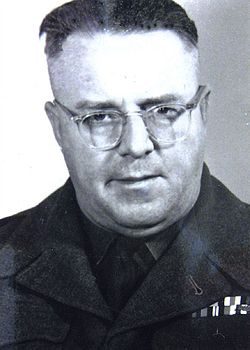Mann, Arnold Rudolph
| Arnold Rudolph Mann | |
|---|---|
| 24 September 1916 – 25 March 1965 | |
 | |
| Place of birth | Gretna, Manitoba |
| Place of death | Kingston, Ontario |
| Place of burial | St. Mary's Cemetery, Port Hope Ontario |
| Allegiance | Canada |
| Service/branch | Canadian Army |
| Years of service | 1941-46; 1950-52; 1954-65 |
| Rank | Signalman |
| Awards | MiD |
Early Life
Arnold was born in Gretna, Manitoba, on 24 September 1916 to parents Jacob and Elizebeth (nee Gross) of Germanic descent who had immigrated from Russia in 1908. He was a second child and had an older sister Helena, and younger sisters Emalie and Bertha.[1]
He received a Grade VIII education in Gretna in 1930 before he left school to work as a farm labourer where he drove horses. In 1935 he started working as a janitor for the Gretna School Board which he did until attesting for service for the Second World War.
Service
He attested for service with the Royal Canadian Artillery at Winnipeg, Manitoba, on 20 May 1941. After receiving signals training at Canadian Signal Training Centre, he proceeded overseas on 21 July 1943. Arriving on 29 July, he was assigned to 1 Canadian Signal Reinforcement Unit. He served briefly with 5th Medium Regiment in August before being assigned again to CSRU. In November he transferred to the Canadian Artillery Reinforcement Unit before joining 3rd Medium Artillery Regiment in December. He proceeded overseas on 6 July 1944 and arrived in France on 8 July and he remained with the 3rd Medium Artillery Regiment throughout hostilities. In August 1945 he transferred to 19 Field Regiment. Returning to Canada in October 1945, he was discharged on 4 January 1946 at Winnipeg Manitoba.
Following the outbreak of the Korean War he re-enlisted at London, Ontario, on 7 September 1950. He joined 2 RCHA Signal Troop, Royal Canadian Corps of Signals and trained in Kingston Ontario at the Royal Canadian School of Signals. In November 1950 he proceeded with his unit to Fort Lewis for training prior to going overseas. He embarked from the USA on 19 April 1951 and arrived in the Far East on 3 May. He served in Korea until 25 May 1952 and was Mentioned in Despatches[2]. He disembarked in the USA on 4 June and was granted 60 days leave. After out processing, he was discharged on 20 August 1952.
On 19 March 1954 he once again enrolled in the Army. He was sent to the Royal Canadian School of Signals where he remained until he was transferred to 1 Canadian Infantry Division Signal Regiment at Camp Borden in January 1955. In September 1955 he was assigned to "K" Troop and served in Europe until October 1957 when he returned to Canada. He was then assigned to the office of the Director of Signals and attached posted to the Royal Canadian School of Signals.
He was admitted to Canadian Forces Hospital Kingston from 24 April until 31 May 1960 for abdominal pain. Nothing was found from that but while there he was diagnosed with Parkinson's disease. He was readmitted to hospital from 15-24 June for a reassessment of treatment for his Parkinson's and a depressive reaction to his diagnosis. His drivers course report from November 1961 states that he suffered momentary blackouts and to being highly nervous when subjected to strain. He froze at the wheel during training and was removed from the course as he "would be a menace to himself and others" if qualified as a driver. He was again admitted to hospital on 23 August 1963 and was discharged on 2 October.
He was pronounce dead on arrival to Canadian Forces Hospital Kingston on 25 March 1965 from Arteriosclerotic heart disease. He was buried at St. Mary's Cemetery, Port Hope Ontario.
Personal Life
Arnold married Nora Marie Forsyth on 12 July 1943.
After the Second World War, Arnold was first a highway labourer and then took up farming and settled in Holyrood, Bruce County, Ontario with his wife. When he re-joined in 1950, he is listed as having three children (other records indicate two). On his 1954 enrollment form, he is listed as separated and his mother is listed as his next of kin.
He married Laurette Marie McEvilia at Kingston Ontario on 24 December 1958 after having received a divorce from his first wife on 15 December.
Related Pages
- No related pages at this time

